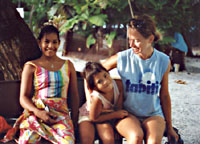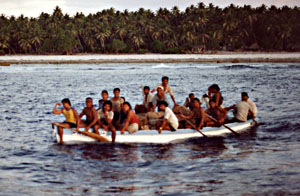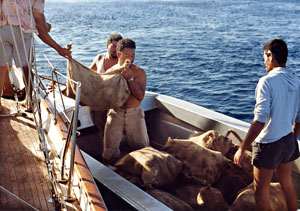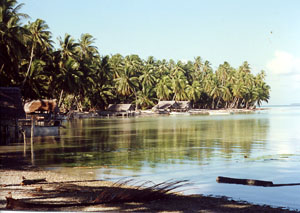Chapter 13 - Suvorov, Puka Puka, and the Samoas Heading to SuvorovWe spent a week back at our old anchorage at the Bora Bora Yacht Club, filling up with water, having one more fabulous dinner at the BBYC, and preparing for the passage to Pago Pago. I took some more photos and picked up some letters for the "48 North" story. Most importantly, I called West Marine Products in California and placed a large order for marine "goodies." It will be sent to General Delivery in Pago Pago, and should be waiting for us when we arrive. The final task was to check out with the gendarme and pick up our bond. Back in April, when we arrived at Hiva Oa, we had to give the bank $850 a piece, to be retrieved, interest-free, upon departure. (The purpose of this bond is to insure that the tourist will not stay forever in French Polynesia. The bond is intended to be sufficient to purchase your airfare back to your home country.) When Candace asked the bank on Friday for our bond money, they said come back on Tuesday when they would have some American money. On Tuesday, they then said they didn't have any American money and that she should come back on Thursday, since Wednesday was a holiday. That was the last straw. Candace had already cooked the meals for the first two or three days at sea, and couldn't tolerate another delay. After some snotty words from the bank pontificate, it was decided that perhaps some additional greenbacks could be accumulated by two o'clock in the afternoon. In the afternoon, everyone was all smiles, with lots of "No problems" and a few other English phrases among the many French ones. We had our money and the weather forecast was promising. The next morning, on August 15, we headed west.
Suvorov IslandSimilar to our passage from Mexico, we checked in to the Pacific Maritime Net every night to report our position and catch up on whereabouts of the other cruisers. Only eleven boats were on the "roll call," and all but three of them were heading to Hawaii or to "the Mainland." After skirting Maupiti and Atoll Motu One to the north, we headed toward Suvorov Island, 685 miles from Bora Bora, and almost directly in line with Pago Pago. That's where we saw a large, whitish whale. He was about 1/2 mile away, and jumped completely out of the water on at least four different occasions. What a fantastic sight. This one large whale, seemingly all alone, jumping straight up and completely out of the water. His nose had to be at least forty feet above the water. Truly majestic! We'd heard about the current inhabitants of Suvorov from Tao, perhaps the "tightest ship" cruising the Pacific. While in Bora Bora, we met Greg and Maria on Tao, along with their 18 year old twins Heidi and Tyson, and 14 year old son Kalen. They had been sailing their 29 foot sloop for the past 5 1/2 years since leaving Vancouver, Washington. Things weren't so crowded when they left, but of course the kids were much smaller then. They were returning to the Northwest, and had recently visited Suvorov Island. But the real story is about Suvorov, one of the northern Cook Islands.
Suvorov, also know as Suwarrow Island, was the island inhabited by the solitary hermit Tom Neal for 16 years. His book, An Island to Oneself must be an inspiration to all the loners in the world. Now, the island is inhabited by four Cook Islanders: Jimmy, the "caretaker" in his mid sixties; Buju, his 22 year old grandson; Sofia, who'd just turned twelve did all the cooking and cleaning; and "Mama," a seven year old girl. I believe that Sofia was "given" to Buju's mother, and might actually be a cousin to Buju. Buju's wife was back in Rarotonga giving birth to his second child. Presumably the first child was "given" to someone else. The implication was that Buju's wife spent very little time on Suvorov. I never understood how Mama joined the family. When we took our dinghy to shore, we already had sketchy bibliographies on the entire population! Sofia was waiting for us when we hit the beach, and in no time charmed us both. She told us she'd been eagerly watching us sail toward the island for several hours, and told the rest of the island "Hurrah, a yacht is coming!" Since Tao had left Suvorov, a Japanese woman in her twenties had chosen to live on the Island for a few months. She spends most of her time talking on the ham radio until the wee small hours of the morning. She also spends some time teaching the young girls. In contrast to the Tahitian children, Sofia and Mama were very well behaved, and seemed quite mature. We thoroughly enjoyed our stay. Unfortunately, we didn't even stay on this lovely island twenty four hours!
The Taro RouteAfter checking into the Roll Call the night before arriving at Suvorov, we were asked to assist in the delivery of some taro root. Two years ago, a hurricane ruined the taro root fields in Puka Puka Island, 215 miles northwest of Suvorov. Until their crop is fully reestablished, Nassau Island, 170 miles NW of Suvorov, has been supplying Puka Puka with the necessary amount of this main staple to their diet. Several weeks ago the inhabitants of Nassau had harvested their crop and arranged for its delivery. The first boat never made it to Nassau, and had to return to port with mechanical problems. A second boat was then commissioned, but unfortunately, it was lost at sea for eleven days and finally ended up in Western Samoa. Apparently there was a serious lack of food and water during her wanderings around the Pacific Ocean. Meanwhile, the taro was still on the beach at Nassau, and was going to rot very shortly. So ham radio operators in Rarotonga tried to seek out any boats in the area who might be able to lend assistance. We were seriously considering the pros and cons of coming to the rescue. There were many unknowns. How much taro was there and how was it packed? Was it very dirty and full of bugs? Since there is no anchorage at either Nassau or Puka Puka, how would we receive and deliver the taro? Would the weather for the next few days cooperate? Talking to Jimmy and the few people on Suvorov Island convinced us that we wanted to help these people. We got partial answers to our questions and prepared to leave early the very next morning.We hoped for good winds so we could arrive at Nassau Island before sunset the next day. With coordination provided by Tom Wichman, ZK1TW, out of Rarotonga, we contacted both islands, and they were eagerly awaiting our arrival. Even before we arrived at Nassau, there was a front page story in the Cook Island News (the country's only daily newspaper) describing the saga. The winds remained strong, and by 1830 we arrived at the "landing" on the lee side of Nassau. It was easy to spot . . . there was a large 200' long freighter, high and dry, rusting away on the reef! On the beach, there were several people waiting for Baba BarAnn. We milled around in the open ocean while the Islanders slowly glided their loaded whaleboat over the reef to join us.
About a dozen young men scampered off their boat onto our heavily fendered boat, and started stacking the bags of taro root around the decks. They were delighted in our picture talking. Only a few spoke some broken English. Although they were most curious, and peered through the hatches, not one even hinted of coming inside our boat. They were delightful, happy, and very appreciative. Before the first bag was loaded they presented us with more than forty coconuts, all husked. In total, forty three bags of taro, about 2,400 pounds, were stowed around the decks. While some returned to shore for more gifts, the majority huddled around the cockpit. I put the "boogie board" in place and played some rock 'n roll, the real international language. After just one playing I think most of them had learned "Barbara Ann," and of course they had learned that our boat was named after the song. Then we were presented with a gigantic basket of "fresh" taro root. After handshakes all around, we parted ways. The next leg on the "taro route" was only 43 miles long, but was the most tricky. About halfway between Nassau and Puka Puka lies Tema Reef. We had to head west to avoid the reef, then jog to the east to prevent the strong current from setting us onto the windward, eastern shores of Puka Puka. The official name for Puka Puka is "Danger Island," because of the many boats that have sunk on their reefs. Of course all this took place in the dark of a moonless night. To prevent arrival before sunrise, we only used the mainsail. Besides, the heavy bags of taro root covered our jib sheets, making access to them virtually impossible. We also discovered several small ants that didn't want to part with their taro. Slowly we probed the darkness, with Baba BarAnn rolling from gunnel to gunnel because of the extra weight on the decks. Between the rocking motion and the navigational concerns, sleep was non-existent. But the weather cooperated, with nice 10-15 knot winds and smooth seas.
At 0700 we rounded the northeastern point of the reef on Puka Puka and were pleased to see a boat waiting for us. Anchoring on the leeward side of the reef was a unique experience. We handed our anchor to Solomon. He motored to the reef, dropped it in just eight feet of water, and then dove down to set it. Even though we were only a few feet downwind from the anchor, we swung comfortably in 200 feet of water. That's how steeply the atoll rises from the bottom of the sea. The taro was off loaded in a few trips, and then we were invited to shore. Our escort was Peiwa, the acting Chief Administrative Officer. We walked around much of the island, spoke to many people, took pictures, and were heaped with lavish praise. Everyone on the island had been anticipating our arrival, and the arrival of their taro. Because the last two boats had failed, our success seemed even greater. After an overly formal thank you speech from the chief consul, we were given two cooked chickens, much taro (it tastes like sticky dumplings, very starchy, and not that special), bananas, papaya, dozens more coconuts, and more sincere gratitude than I would have believed possible. We hosed down the decks, stashed all our bountiful presents, and set sail for Pago Pago, 373 miles to the southwest. After enjoying chicken for both lunch and dinner, we "crashed." We were both bone tired after being up for 36 hours.
Carina was three days behind us and they too had decided to come to the rescue, bringing the last 38 bags of taro for the ever thankful people of Nassau and Puka Puka. Carina and Baba BarAnn were the second and third yachts to visit Puka Puka this year, and certainly the most appreciated in a long, long time. We were even told that the prime minister of the Cook Islands would welcome us [telegram from the Deputy Prime Minister] if we ever got to Rarotonga. We'll see! Rarotonga is on our itinerary for next May. Normally Puka Puka receives two supply boats per year. They exist on fish, taro, a few chickens and pigs, some bananas and papaya. While they have a few modern conveniences, their culture appears to be unchanged, and certainly unharmed, by "civilization." We asked how they got the one tractor to shore. Easy! They took it apart, ferried it ashore in small whale boats, and then reassembled it on shore. On the way to Pago Pago we stopped at Tau, [in the NW corner near Faleasao] one of the Manua Islands about 60 miles east of Pago Pago. It was such a rolly anchorage, we only stayed long enough to shower and have dinner. After a few hours we pulled the anchor back up and continued on to Pago Pago, arriving before noon the next day, Sunday, August 26.
Pago PagoPago Pago, American Samoa, (pronounced "pango pango") is much maligned. We've read that the customs officials are the rudest in the Pacific, and that they've even stolen articles and money from cruisers. The Samoans are big and aggressive, shoving their way around stores and acting unfriendly to all cruisers. The harbor [detailed chart] is polluted and smelly from oil spills and the tuna packing factories. Except for the pollution, our experience has been contrary to the above. We tied up to the customs dock on Sunday afternoon. Monday morning at 8:30 we were visited by customs, immigration, the port authority, and health officials. Everyone was extremely pleasant and efficiently processed a modest amount of paperwork. They didn't snoop around the boat, and only asked a minimum of questions. Then we went to the harbor master, about a mile away, and finished the entire paperwork process. By 10:00 we were done. Yes, the men and women are quite large, heavy with broad shoulders. But during our two weeks there, we didn't see any action that might be considered aggressive or unfriendly. Quite the contrary, they were all very courteous. The harbor is terribly polluted from oil spills and trash. It's almost as filthy as Ensenada, Mexico. Sometimes we can smell the tuna processing plant when the air is still, but it hasn't been remotely close to the unbearable levels we were anticipating. My biggest objection, outside the dirty water, is the noise pollution. Turbines hum loudly 24 hours a day, every day. It's just like being at an airport. We close the hatches at night and turn our fan on. This creates a nice artificial breeze, and the lower pitched hum of the fan is less objectionable. The heat and humidity of Pago Pago are oppressive.
Maintenance and ProvisioningAh, but the real reasons for coming here are the US prices and US mail. After 4 1/2 months in French Polynesia, regular USA prices seem fabulous. My package of "goodies" from West Marine Products was awaiting our arrival. Our mail and photos arrived the next day. We stocked up on everything to carry us through until arrival in New Zealand. On the diesel engine I changed the oil, oil filter, fuel filter and fan belt. I cleaned the air filter and the turbo charger, checked the water pump impeller and gear oil, and cleaned the outside of the engine. I also cleaned and lubed some of the winches and the steering system. It was dirt cheap to have the laundry clean and fold a large bag of clothes. Candace got some prescriptions filled at half price, and I had a cavity refilled for only $20. Medical care is free for the residents of American Samoa, and inexpensive for the visitors. It's all paid for by U.S. taxpayers. The bus system is strictly private enterprise. Since there are at least twice the number of buses needed for the population, one seems to come every other minute. Almost all rides are just 25 cents. The buses are miniaturized, about one-fourth the size of a "real" bus, and they all BLAST reggae, rap, and native music. While there, we also caught up on the news, thanks to our TV which brought in English speaking stations for the first time in nine months. What a mess in Kuwait! After 12 days we had done all those things that needed to be done, filled the larder and all the tanks, and were ready to leave. The noise and harbor pollution were starting to get to us. The Korean fishing boats just dump their bilge water into the harbor, along with lots of trash, when they bring their catch to the canneries. With the harbor such a mess, there seems to be little incentive to keep the streets and surrounding area clean. Our waterline was black from oil, while pink "things" were starting to grow on the bottom. Our harbor fee for the privilege of staying here was $68. But first we had to haul our stern anchor. After two hours of tugging and hauling from every direction, we finally saw our Fortress (Danforth style) anchor. It was completely entangled in a gigantic nylon bird's nest, with perhaps 200' feet of 1/4 inch anchor line. Using cable cutters I was able to free the anchor from the harbor, and us from Pago Pago.
Apia, Western SamoaWith good winds most of the way, we made the 90+ mile trip to Apia in 18 hours, arriving on Sunday morning, September 11. Despite the short distance of the trip, we'd obviously come a very long way from Pago Pago. The harbor was very clean; the city was clean. It seemed like the cars were traveling along the harbor road in slow motion. No hectic pace here. That very proper air of a British heritage was quite evident. We loved it. We enjoyed a guided bus tour all around the island, which also took us swimming at a beautiful beach and a waterfall. Everywhere, the children smiled and waved when we drove through their little community. Despite what our friends on Tao had told us about the aggressive, unfriendly Samoans, we had to disagree totally. These were unquestionably the most friendly and polite people we had ever met . . . anywhere in the world. How ironic. The only harbor that has ever charged us to deposit our trash, one tala or 47 cents US per bag, is perhaps the cleanest one we've been to. Public education is not free, but there's a 90% literacy rate in the country. Most of the "money" in this country seems to belong to the numerous churches. We saw large Roman Catholic, Methodist, Bahai, Assembly of God, Congregational, and Mormon churches. Small villages, with perhaps 50-100 people, support at least two large churches. The entire country shuts down on Sundays. It's against the law to do any work on the Sabbath. Property is owned by the community, not by individuals. We've heard that the "squabbles" between communities, usually over property, are sometimes settled with violent rock throwing fights. I can believe it. Twice I've seen kids throwing rocks at other kids. Everyone seems to throw rocks at the mongrel dogs which roam the streets, eking out an existence. On these volcanic islands, there's plenty of ammunition! It seems that the Samoans have a violent streak, just below their friendly, polite veneer.
Taro Route - Part IIWhile in Apia, we wanted to learn more about the boat that was lost at sea for eleven days when attempting to pick up "our" taro from Nassau Island. Without success, we went to both newspapers and the library. Then we went to the Ministry of Transport and had a long talk, "off the record," with Richard Henshaw. He's employed under a two year contract with the Western Samoan government to help the port of Apia. The lost boat, Fotu-O-Samoa (Fotu) is owned by the government of Samoa. The Cook Islands had chartered Fotu to carry about 50 people from Puka Puka to Rarotonga to participate in the Independence Day festivities during the first week in August. This request was originally denied, since neither the boat nor the crew of Fotu were licensed for international business. However, since one of the very few ways Western Samoa can earn "hard currency" is by chartering this boat, this denial was overruled by Richard's boss, the Chairman of the Ministry of Transport. If there were any problems, the insurance coverage would not apply, and the government could be liable for significant law suits. The boat was in poor shape, with a badly twisted prop, and the crew had a history of mistakes. Fotu picked up the passengers at Puka Puka and headed south to Rarotonga. However, their SatNav started to act up, and became completely unreliable. There was no sextant on board, nor nautical almanac. After the boat was two days overdue in Rarotonga, a search plane was sent out. Amazingly it found Fotu about 200 miles north of Rarotonga, while she was steaming NE under the false assumption that she had overshot Rarotonga. With some radio guidance from the plane, Fotu headed off in the correct direction. Once again it changed course, was found, and received help. By now there was a serious lack of food and water for the fifty passengers and crew. Finally the boat limped into Rarotonga, with the passengers completely missing the festivities. Fotu picked up three passengers for a return trip to Nassau. Before heading off, Fotu's owners agreed to a suggestion that the harbor master from Rarotonga, who knew these waters well, travel on the boat. However, after pleas from Fotu's captain that this would be embarrassing, "trust me, I can do it," the harbor master was told to get off the boat. At least the harbor master convinced Fotu to borrow his sextant and nautical almanac. The Cook Islanders then asked Fotu to pick up the taro root from Nassau and deliver it to Puka Puka. So off she headed for Nassau Island. Of course she got totally lost again. At one point she was 300 miles NW of her "assumed position," and almost hit a reef in the middle of the night. While trying to ascertain Fotu's position, they had radioed Apia with a sextant observation. It was another comedy of errors as the people in Apia tried to find a current nautical almanac to reduce the sights, in order to verify Fotu's calculations. Finally, they went to one of the cruising boats, Interlude, that was at the custom's dock and asked for assistance. While in Apia, we met Gordon and Donna from Time Bandit, a 65' trimaran from Hawaii, and enjoyed hearing their part of the "Taro Route." Soon after Carina had delivered the second batch of taro, the people on Suvorov Island convinced Time Bandit to transport 90 people (about 30 were small babies) from Nassau to Puka Puka. Time Bandit agreed, and made two trips to complete the task. They only had celestial navigation (no satellite navigational system) and had trouble locating Nassau on the return trip, because of overcast skies. After several passes north and south of the island, the clouds lifted long enough to find the elusive island. Remember, Nassau is only one mile in diameter.
Food PoisoningIn Apia, we went to the famous Aggie Grey Hotel for the Samoan dancing, singing, and buffet dinner. We think it was there that Candace picked up a terrible case of food poisoning, although it may have been at a pastry shop where we got a small lunch, earlier in the day. Her temperature peaked at 103.5, her stomach (left side) hurt, and many of her muscles ached very painfully. At first we thought it was Dengue fever. Now we think it was salmonella. After "keeping our guard up" so diligently in Mexico and French Polynesia, we had lapsed. Perhaps just hearing the locals speak English lulled us into a false sense of security. Lots of Gatorade, and some antibiotics, cured her in less than a week, but it was a miserable time for Candace.
|



